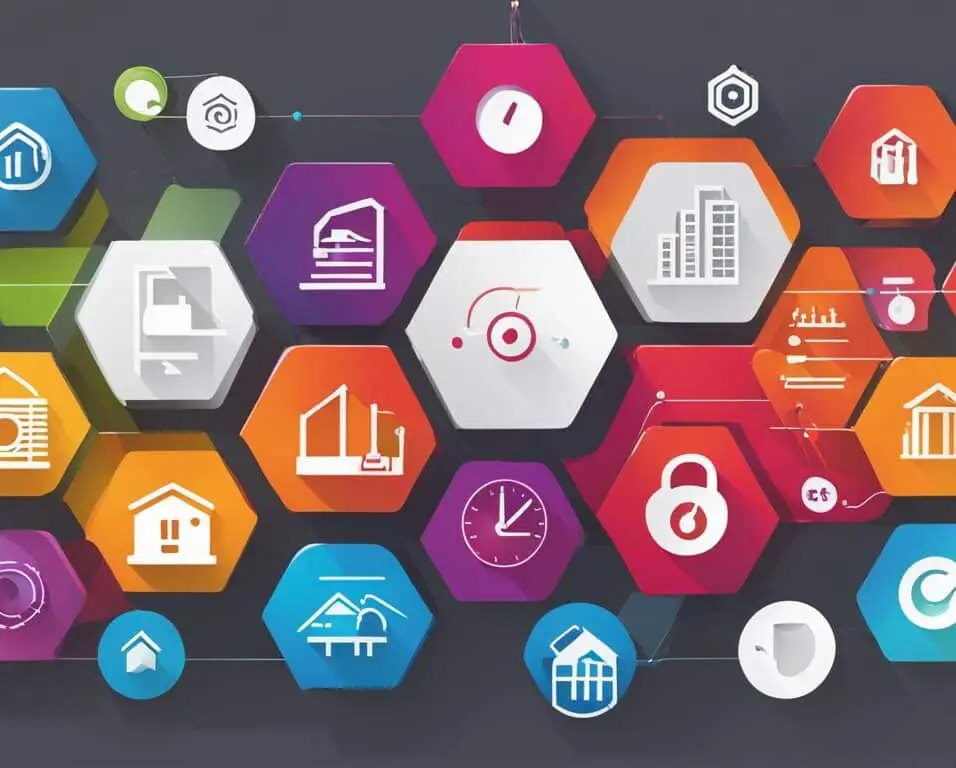Maximizing Home Efficiency with IoT Integration
Energy efficiency has always been a crucial aspect of our lives as we strive towards a sustainable future. With the advancement of technology, the possibilities for enhancing energy efficiency have grown exponentially. One area where technology has shown tremendous potential is in integrating smart technology into energy systems.
Key Takeaways:
- Smart technology in energy systems allows for real-time monitoring, data analysis, and automation.
- The Internet of Things (IoT) enables the integration of interconnected devices and sensors for efficient energy management.
- IoT integration brings benefits such as improved energy management, enhanced maintenance, demand response, and increased grid reliability.
- By embracing IoT integration, we can maximize home efficiency, contribute to environmental sustainability, and unlock the benefits of energy-efficient living.
The Rise of Smart Technology in Energy Systems
In recent years, smart technology has revolutionized various aspects of our daily lives. From smartphones that keep us constantly connected to intelligent virtual assistants like Amazon’s Alexa and Google Assistant, the world has witnessed a rapid evolution of devices designed to make our lives easier and more connected.
Now, this same concept is being applied to energy systems, ushering in a new era of efficiency and sustainability. Smart technology in energy systems refers to the integration of sophisticated sensors, advanced analytics, and automation to optimize energy consumption and overall system performance.
At the heart of this integration is real-time monitoring, which allows for the collection of data on energy usage, environmental conditions, and system performance. By continuously analyzing this data, energy systems can make intelligent decisions in real-time, resulting in improved energy efficiency.
Furthermore, through data analysis, trends and patterns can be identified, enabling proactive measures to optimize energy consumption, predict maintenance needs, and improve overall system performance. With the power of data analysis, energy systems can adapt and respond to changing conditions, leading to a more efficient and sustainable energy infrastructure.
“The future of energy systems lies in harnessing the power of smart technology and data analysis to optimize energy consumption and contribute to a more sustainable future.”
Automation also plays a key role in smart technology integration. By automating various tasks and processes, energy systems can operate more efficiently, eliminating human errors and optimizing energy consumption based on real-time data inputs.
Remote control capabilities further enhance the functionality of smart energy systems. With remote control, users can access and manage their energy systems from anywhere, providing them with the flexibility to monitor and control their energy consumption even when they are away from home.
Moreover, smart technology integration in energy systems extends beyond efficiency improvements. It also facilitates the integration of renewable energy sources, such as solar panels and wind turbines. By seamlessly integrating renewable sources with traditional energy systems, smart technology enables a more sustainable and environmentally friendly energy infrastructure.
The benefits of smart technology integration in energy systems are vast, ranging from reduced energy costs and improved energy management to increased comfort and convenience for users. Additionally, it plays a crucial role in reducing carbon footprints, enhancing grid reliability, and paving the way for a more sustainable future.
The Future of Energy Systems is Smart
The integration of smart technology into energy systems marks a significant shift towards a more efficient and sustainable future. By harnessing the power of real-time monitoring, data analysis, automation, remote control, and integration with renewable sources, energy systems can optimize energy consumption, reduce waste, and ultimately contribute to a greener world.
Next, we will explore the role of the Internet of Things (IoT) in energy systems and the specific benefits it brings to the table.
The Role of Internet of Things (IoT) in Energy Systems
One of the driving forces behind the integration of smart technology into energy systems is the Internet of Things (IoT). The IoT refers to a network of interconnected devices and systems that can communicate and share data. When applied to energy systems, the IoT creates a web of connected devices, sensors, and infrastructure, enabling efficient energy management.
IoT devices and sensors can collect data from various sources within an energy system, including appliances, smart meters, and weather stations. This data, combined with advanced analytics, provides valuable insights into energy usage, allowing for informed decision-making and proactive energy management.
In the context of energy systems, IoT devices and sensors act as the digital nerve system, constantly gathering data on energy consumption, system performance, and environmental factors. This real-time data allows energy system operators and homeowners to gain a deep understanding of their energy usage patterns and identify opportunities for optimization.
By leveraging the IoT’s interconnectedness and the data it generates, energy systems can be fine-tuned, resulting in improved efficiency and reduced energy waste. The ability to monitor energy usage in real-time helps identify trends, potential problems, and areas for improvement.
Furthermore, IoT integration enables interconnected devices to work harmoniously, responding to data-driven insights. For example, smart thermostats can adjust the temperature based on occupancy patterns detected by motion sensors, optimizing energy usage and reducing unnecessary heating or cooling.
Enhancing Energy Efficiency with IoT Data Analytics
IoT’s impact on energy systems is further amplified by the power of data analytics. The vast amount of data collected by IoT devices can be processed and analyzed to uncover valuable insights, creating a pathway toward optimizing energy consumption patterns.
Data analytics helps detect anomalies, identify energy-saving opportunities, and simulate scenarios for energy optimization. By utilizing sophisticated algorithms and machine learning techniques, energy management systems can automatically adjust energy usage based on historical data and real-time conditions, resulting in significant energy savings.
The ability to analyze data and extract actionable insights is crucial for energy systems seeking effective strategies for energy management, load forecasting, demand response, and grid optimization. Data analytics provides the necessary intelligence to achieve energy efficiency goals, reduce costs, and minimize environmental impact.
With the IoT and data analytics at the core of energy systems, a new era of energy management is unfolding, empowering individuals and organizations to adopt sustainable practices and contribute to a greener future.
| Benefits of IoT in Energy Systems | Description |
|---|---|
| Improved Energy Efficiency | The ability to gather real-time data and make data-driven decisions leads to more efficient energy consumption and reduced waste. |
| Enhanced Maintenance | IoT-enabled devices provide continuous monitoring and diagnostics, enabling proactive maintenance and minimizing downtime. |
| Demand Response | IoT integration facilitates demand response programs, where electricity providers incentivize customers to reduce energy usage during peak demand periods, supporting grid stability. |
| Increased Grid Reliability | Improved monitoring and control capabilities enabled by IoT technology enhance grid reliability and resilience. |
Benefits of IoT Integration in Energy Systems
IoT integration in energy systems brings numerous benefits. By leveraging the power of interconnected devices, advanced analytics, and real-time data, energy management is greatly improved, leading to better control, optimization, and reduced costs.
One of the key advantages of IoT-enabled devices in energy systems is their ability to provide real-time information about equipment performance. This enables proactive maintenance and minimizes downtime, leading to enhanced maintenance practices and increased equipment lifespan.
The IoT also plays a significant role in demand response programs. Through IoT integration, electricity providers can incentivize customers to reduce their energy usage during peak demand periods. This helps stabilize the energy grid, ensuring a reliable and stable supply of electricity to consumers.
Furthermore, IoT integration enables better monitoring and control of the energy grid itself. The ability to collect data from various sources within the grid allows for improved grid reliability and resilience. This ensures a more efficient distribution of energy and enhances overall grid performance.
By incorporating IoT integration into energy systems, we can reap the benefits of improved energy management, enhanced maintenance practices, demand response programs, and increased grid reliability. This not only contributes to a more sustainable future but also paves the way for a more efficient and resilient energy infrastructure.

With IoT integration, energy systems can achieve improved energy management, enhanced maintenance, demand response, and increased grid reliability.
Conclusion
Integrating smart technology into our energy systems is an essential step towards a greener and more sustainable future. By leveraging real-time data, advanced analytics, and automation, we have the power to optimize energy consumption and reduce waste. The advantages of IoT integration in energy systems are numerous, from improved energy management to enhanced maintenance and increased grid reliability.
With IoT integration, we can maximize home efficiency and contribute to environmental sustainability. By monitoring and controlling energy usage in real-time, we can make informed decisions and proactively manage our energy consumption. This optimization not only reduces costs but also minimizes our carbon footprint, paving the way for a more sustainable future.
The benefits of IoT integration extend beyond the individual level. Demand response programs, made possible through IoT-enabled devices, allow electricity providers to incentivize customers to reduce their energy usage during peak demand periods. This collaboration contributes to stabilizing the energy grid and ensuring a reliable supply of electricity for all.
Embracing IoT integration in energy systems unlocks countless benefits for individuals, communities, and the planet as a whole. By embracing energy-efficient living, we can create a brighter tomorrow characterized by improved energy management, enhanced maintenance, demand response, and increased grid reliability. Let us move forward together towards a sustainable future.
FAQ
What is smart technology in energy systems?
Smart technology in energy systems refers to the integration of sophisticated sensors, advanced analytics, and automation to optimize energy consumption and overall system performance. This integration allows for real-time monitoring, data analysis, and intelligent decision-making, resulting in improved energy efficiency across various sectors.
What is the Internet of Things (IoT) and how does it relate to energy systems?
The Internet of Things (IoT) refers to a network of interconnected devices and systems that can communicate and share data. When applied to energy systems, the IoT creates a web of connected devices, sensors, and infrastructure, enabling efficient energy management. IoT devices and sensors can collect data from various sources within an energy system, including appliances, smart meters, and weather stations. This data, combined with advanced analytics, provides valuable insights into energy usage, allowing for informed decision-making and proactive energy management.
What benefits does IoT integration bring to energy systems?
IoT integration in energy systems brings numerous benefits. It enables improved energy management, allowing for better control, optimization, and reduced costs. IoT-enabled devices can provide real-time information about equipment performance, enabling proactive maintenance and minimizing downtime. The IoT facilitates demand response programs, where electricity providers can incentivize customers to reduce their energy usage during peak demand periods, helping to stabilize the energy grid. Additionally, the IoT enables better monitoring and control of the energy grid, improving grid reliability and resilience.
How does integrating smart technology into energy systems contribute to a greener future?
By harnessing the power of real-time data, advanced analytics, and automation, integrating smart technology into energy systems can optimize energy consumption, reduce waste, and contribute to a greener future. This integration allows for improved energy management, enhanced maintenance, demand response, and increased grid reliability. By embracing IoT integration, we can maximize home efficiency, contribute to environmental sustainability, and unlock the countless benefits of energy-efficient living.
Source Links
- https://blog.attuneiot.com/2017/10/03/maximize-energy-performance-contracting-with-iot
- https://utilitiesone.com/energy-saving-technology-integration-smart-home-devices-for-overall-efficiency
- https://utilitiesone.com/the-role-of-iot-in-building-energy-management-100-ideas-for-article-headings-iot-integration-and-energy-efficiency-in-buildings








